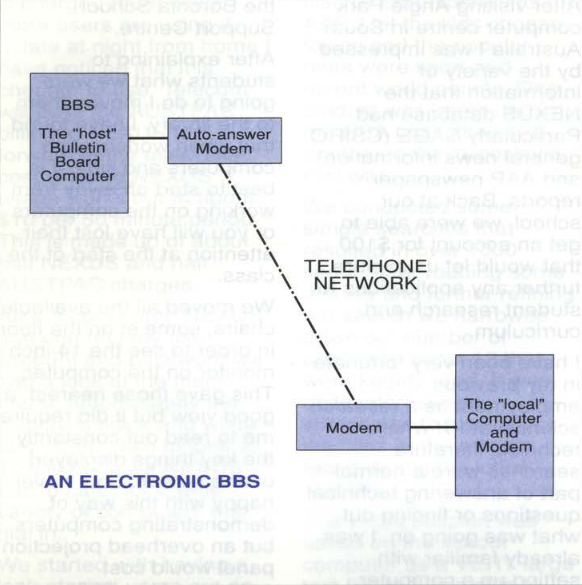Issue 4
Term 4 1992
What is an Electronic Bulletin Board?

A bulletin board system (BBS) is a computer network that allows users to communicate with each other electronically, and share data.
The linking of computers can be achieved by many means. These include dedicated cables, satellite links, telephone lines and other forms of electronic communications. Typically BBSs utilise phone lines to transfer data. B
BSs consist of a central computer which acts as a message store. This computer is permanently connected to a phone line by modem.
Individuals using a computer and modem, can link into this service to leave a message. The central computer is controlled by special software that allows it to store messages, as well as send messages to callers. Over a period of time this service evolves into an electronic bulletin board.
How do Bulletin Boards transfer messages?
In order for your computer to be able to "call" the central computer, communications software must be installed. Communications software controls the operation of your modem and the transfer of the information between coputers. Public Domain (free) communications software is available as well as commercial programs.
Communications with your neighbour or the rest of the world.
There are a variety of BBSs currently operating in Australia. Some of the educational ones include CITY LIMITS, COMET, EDMAC and TEMPEST. All of these BBSs are free to registered users, Provided that your computer has suitable communications software, for the cost of a telephone call, you can link into any of these.
The terrific part is that messages can be left on the bulletin board for individuals or for all callers to read. A bulletin board is a great way to ask others for advice, hear about interesting activities, or simply chat.
In order to cater for different interests, BBSs are divided into various chat areas, or "echoes". This means that teachers can chat with other teachers, and students with other students. In addition to communication within a local area, some BBSs provide international chat areas which can be accessed for the cost of a local telephone call.
Bulletin Boards and file exchange
Aside from leaving short messages, callers can send larger files to the central computer, These might include shareware software, educational material, or other interesting documents. The central computer is able to store files, which other callers can download to their own computers.
Bulletin Boards and Database
Educational BBSs such as NEXUS and KEYLINK (see Connections 2 1992) also provide access to educational programmes such as WRITERS ON LINE or FROGWATCH and to databases such as SAGE and AAP.